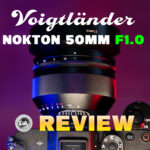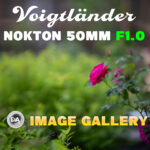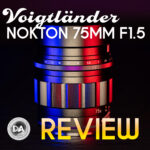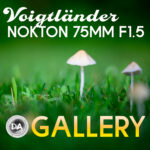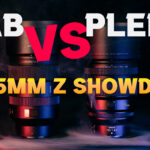
I’ve had a long lasting love affair with vintage glass. Even though my contemporary lens collection features dozens of great lenses, I still have 6 or 7 vintage lenses that I enjoy taking out periodically. Some of those include classic SMC Takumars and Zeiss lenses, while others include some of the cult classics like Soviet Helios and Jupiter lenses. The latter category I have prized because of their unique “swirly” bokeh. These lenses are often optical designs derived from Carl Zeiss, and almost all of the lenses I own are based on the old M42 screw mount. Many of these lenses have gotten some revival in the mirrorless era, as they can be fairly easily adapter and mirrorless cameras have manual focus aids that make using them easier than ever. There is a subset of photographers who are turned off by modern lenses that are perfectly corrected, and they are more interested in lenses with some individuality and character.

I’ve wasted a lot of time down the eBay rabbit hole trying to find some of these classic gems at a reasonable price, but some of them are surprisingly expensive. The Zeiss Biotar 75mm F1.5 can cost thousands of dollars. But what if you could get a modern version of that exact lens for under $300? If that sounds intriguing, join me in exploring the unique TTArtisan 75mm F1.5 in either my video review or the text review that continues below.
Follow Me @ YouTube | Patreon | Instagram | Facebook | DA Merchandise | Flickr | 500px | X
__________________________________________________________________________________________________
Thanks to TTArtisan for sending me a review loaner of this lens. As always, this is a completely independent review. *The tests and most of the photos that I share as a part of my review cycle have been done with the Sony a7RV along with the Sony Alpha 1 that serve as my benchmark cameras for Sony lenses.
__________________________________________________________________________________________________
TTArtisan has chosen one of the three different housing designs this optical formula had in the past, which is often called the “Fat Version” that was sold from 1952-1967. The end result is a stubby lens that reminds me a lot of the recent Voigtländer Nokton 75mm F1.5 that I reviewed earlier this year. It has the scalloped focus ring, all metal body, and anodized finish of that lens.

This is built around that same old M42 mount, so that comes with both blessings and curses that we will explore. The upside is that the M42 is easily adaptable to a wide variety of lens mounts, up to and including Fuji’s medium format GF mount. I used to mostly use M42 glass on Canon EF mount, where the adapters would be quite slim, but because of the different flange distance on mirrorless cameras, you have to use much thicker adapters to get the optics where they need to be. You can see that the Vello adapter I used here is pretty chunky, which adds a fair bit of length to the overall package, unfortunately.

Initially the lens didn’t lineup quite right for me, but fortunately they have thought about that, as you can mount the lens to your camera, and then use the included allen key to loosen three screws near the lens mount, which will then allow you to rotate the lens to the proper position before tightening it back down.

It’s a good solution to a common problem with lenses like this. Let’s take a closer look at the performance.
Build and Handling
The TTArtisan 75mm F1.5 Swirl has classic good looks. The lens has some heft to it, weighing in at roughly 570g (20oz). I measure the lens at roughly 73mm in diameter and about 72mm in overall length. The lens will grow an additional 10mm in length when focused to the minimum focus distance (externally focusing).

We have a common 58mm front filter thread on the front of the lens.

There are two rings on the lens. The first is the manual focus ring, which is the widest part of the lens and has easy to grip metal knurls.

There are etched distance markings with metric in white and Imperial distances in yellow. The lens barrel before the ring has hyperfocal markings (from F1.5 to F16) on it.

The second ring is near the front, and it a manual aperture ring. This is a clicked aperture with detents at the half stop position from F1.5 to F5.6, then only full stops. There are markings for each full aperture (starting at F1.5, then F2, F2.8, etc…). The aperture ring moves with nice precision.
There are thirteen rounded aperture blades inside that make for a pretty sexy looking aperture.

Minimum focus distance is 75cm, and the resulting magnification is not particularly high (probably in the 0.10x range).

There is no weather sealing, no electronics, or anything particularly modern. You’ll need to manually set the focal length for in-camera stabilization if your camera is so equipped. You will also miss a lot of EXIF data (only the camera based information like shutter speed and ISO will be recorded, though if you are shooting on Nikon you’ll have a chance to manually input some of that information).

The front cap is an old school threaded variety.
All told this is a nicely made lens that focuses nicely, has good aperture control, and costs a whole lot less than grabbing one of the classic lenses it emulates.
Manual Focus on Sony (Alpha 1 and a7RV)
When I first moved to Sony bodies, I found them a wonderful platform for manual focus. They had IBIS (in-body-image-stabilization), good viewfinders, and much more manual focus aids than the DSLRs that I was accustomed to. Since that point, however, essentially the whole industry has shifted to mirrorless cameras, so those advantages aren’t as distinct anymore. But I still found the TTArtisan 75mm F1.5 Swirl an easy lens to use on my Sony bodies and found that I could easily nail focus despite the large maximum aperture and narrow depth of field. Here’s a few reasons why:
- EVF. An electronic viewfinder has a lot of advantages over an optical viewfinder when it comes to using manual focus lenses. You have the ability to see overlays, magnify the image to confirm focus, and as a byproduct I really didn’t have any misses. I don’t always love Sony’s viewfinders due to them going a bit weird when you half-depress the shutter for stabilization, but focus is still really easy due to the EVF.
- Effective IBIS (Steadyshot Inside). Sony was a pioneer with IBIS, and while other companies have caught up and even surpassed them, having the ability to stabilize the viewfinder or LCD screen image while focusing makes manual focus much easier. You can hold that image still while you pull focus to the perfect point.
- Useful manual focus aids. Sony’s options include the ability to have a color overlay to help to show what is in focus, though I will note that this works better when shooting at larger apertures and at close to medium distances. At longer distances where more is in focus, the color overlays can just become distracting, and just because a lot is in focus doesn’t yet mean that focus is where you want it. I prefer the secondary method, which is to enable an automatic magnification of the focus area whenever you turn the focus ring. This allows you to visually confirm focus is where you want it, and it is pretty foolproof. Sony’s system will both automatically magnify the focus area when you turn the focus ring and then also switch back to the full view when you go to depress the shutter so that you can ensure your composition is still what you want.
I own four different brands of camera (Sony, Canon, Nikon, and Fujifilm), and I can safely say that manually focusing on each of them is really quite easy…even when focusing on very shallow depths of field.

It is worth noting that the beautiful focus ring also makes doing focus pulls during video a treat. There’s nothing quite like a well calibrated true manual focus ring for smooth pulls.
TTArtisan 75mm F1.5 Swirl Image Quality Breakdown
This “swirl” lens has an extremely simple optical design of 6 elements in 4 groups. Two of those are HR elements.

Lenses like this are all about the rendering, the “look”, and not about their technical proficiency. I haven’t seen an MTF chart that looks this bad in a long, long time!

There’s a huge disparity between the wide open performance and the stopped down performance. The corners are particularly weak, but that’s essentially part of the design. The “swirl” that is so desirable in these lenses actually comes from uncorrected aberrations in the sagittal plane. In fact, most of the unique and desirable qualities we like about vintage glass come from optical defects, which is why modern lenses often feel fairly “clinical” by comparison. There’s a lot of defects in this image…but that’s a big part of the charm!

On the technical side of things, there is relatively little distortion and vignette.

There is a very small amount of barrel distortion (+3 to correct) and under 2 stops of vignette (+45 to correct). Neither metric is bad at all, which is good, as obviously lenses without electronics like this won’t get any kind of in camera corrections.
Not so good, however, is color fringing, particularly in high contrast situations. This is not a lens that will always hold up well when there are brighter lights in the frame. You’ll also see some color fringing before and after the plan of focus, and a general spherical aberrations that softens contrast (what we often euphemistically call “dreamy rendering”).


Other shots in lower contrast situations look better.


Stopping down a bit helps with the fringing in most situations.
Control of Lateral CA was pretty much perfect. The transition from black to white is flawless near the edge of the frame.

We can clearly guess that at large apertures, this is not going to be a very sharp lens, particularly when we consider that I am testing on a much higher resolution point than any classic lens had to deal with. All of my chart tests are shot on the 61MP Sony a7RV sensor with crops shown at roughly 200% magnification. Here’s a look at the test chart, which looks a bit like it is warping due to the unique optical signature of this lens.

And here are the F1.5 crops from across the frame:



There’s actually a decent amount of detail in the center of the frame, but you can also see that some fringing is reducing contrast, giving the textures a bit of a “bloom” to them. The midframe and corners are softer still, but it is mostly due to having very low contrast.
That’s all part of the unique look of the lens, however.

I did note some of the typical quirks with metering as I stopped the lens down for my test chart results. I found that I needed to bias results sometimes to keep metering accurate. As I got into the smaller apertures, it was not unusual to get underexposed results like below if I didn’t.

Stopping down to F2 will increase contrast a bit and eliminate a lot of the fringing. You can see that the whole image looks cleaner and brighter.

If we look in the center of the frame, we can see that the resolution and contrast have picked up considerably. It’s like a whole new lens.

The corners are a different story, however, as, while they are brighter, then look like they are in a fog and the sun is just starting to come out a bit!

Corners never get pin sharp, though they are pretty decent by F5.6:

Landscape apertures of F4-F8 look pretty good other than the extreme edges of the frame.



As expected on a high resolution body, diffraction will hit after F8, softening the image a bit at F11 and more so at F16, which is minimum aperture.

So sharpness and contrast will vary dependent on the aperture you choose, which does give you some flexibility with the kinds of images that you can create with the lens.
But if you are buying this lens for sharpness, you’ve missed the point. This is a lens that is more about what’s out of focus than what is in focus. So let’s talk about that bokeh. First of all, the lens is very capable of producing soft, creamy bokeh. Here’s a look at a scene where I’ve pulled focus back to minimum so everything is out of focus.

There’s actually a specific difference where the swirl is most pronounced. That will be shooting at F1.5 and a medium distance of about two meters.

If I focus further, we can see that there is relatively little swirl effect, so it really only works with the background, not the foreground.

On a practical level, this effect works best when there is something on either side of the subject to serve as the bokeh subject. Putting your subject near the center of the frame works better than composing in the rule of thirds zone, as the plane of sharpness is mostly located in the center of the frame and you can get better subject separation. I put my subject in the rule of thirds for this shot, but it doesn’t work as well.

The effect will be more pronounced with a larger sensor. Medium format users will see the biggest effect, while APS-C cameras will crop off a lot of the swirly look. You can obviously get a fair bit of the effect on full frame as well (as shown in this review).
Stop down a bit, and you can get a more conventional image, like this:

Likewise for landscape shots. Shooting at F5.6 or F8 makes for a pretty conventional looking image.

Flare results are going to be situational. In certain positions there’s a general veiling over a shot, like this:

At wider apertures you may see a ghosting artifact like this:

At its best, you can get some fairly artistic effects that really go along with the vintage charm of the lens.

I would say the results are generally better than some of the vintage glass I’ve used, but not as corrected as a modern lens with effective coatings.
I would say that color is good in most situations. Here, for example, it looks great:

It’s also great here.

But if you are shooting high contrast scenes at large apertures, the general lack of contrast can make colors look a little dull.

I would say that this is both part of the charm and the liability of a lens with vintage sensibilities. Use the TTArtisan 75mm F1.5 “Swirl” to its strengths, and you can get much more interesting images than a conventional lens. Use it poorly, and you’ll just get low contrast, mushy images that neither you or your audience will enjoy. You can see more images by visiting the lens image gallery here.
Conclusion
I’ve definitely intentionally sought out some of the “swirl” lenses myself in the past. It is great to see TTArtisan bringing back some of these fun and interesting optics to a modern audience in the TTArtisan 75mm F1.5.

This lens has to be evaluated with a different set of criteria than my typical lens review, because by definition this swirl lens in embracing certain optical flaws that make for visually interesting results.

Yes, you can get conventional looking results with this lens at small apertures, but that’s not really the reason to buy it.

The real reason to buy this lens is to fully embrace the swirly flaws and to shoot the kinds of images you’ll never get with almost all modern lenses. And with a price tag of just $270 USD, you don’t have to break the bank to get it. Just remember to pick up a cheap adapter for your preferred mount if you don’t already have one!

Pros:
- The swirl!
- Nicely built lens
- Well executed focus and aperture rings
- Low distortion
- Bright aperture
- Good sharpness when stopped down
- Nice color in some situations
- Unique and special rendering
- Much cheaper than trying to find a vintage lens that does the same thing
Cons:
- Low contrast and some fringing
- Some flare issues
- Corners never really get super sharp
- Requires an adapter for any modern camera
_________________________________________________________________________
GEAR USED:
Purchase the TTArtisan 75mm F1.5 Swirl @ Vitopal | B&H Photo | Adorama | Amazon | Amazon Canada | Amazon UK | Amazon Germany
___________________________________________________________________
Purchase the Sony a7RV @ B&H Photo | Adorama | Amazon | Camera Canada | Sony Canada | Amazon Canada | Amazon UK | Amazon Germany
__________________________________________________________________
Purchase the Sony a7IV @ B&H Photo | Adorama | Amazon | Camera Canada | Sony Canada | Amazon Canada | Amazon UK | Amazon Germany
_________________________________________________________________
Want to support this channel? Use these affiliate links to shop at: B&H Photo | Amazon | Adorama | Camera Canada | Amazon Canada | Amazon UK | Ebay | Make a donation via Paypal
Buy DA Merchandise https://bit.ly/TWIMerch

Keywords: TTArtisan, 75mm, F1.5, swirl, swirly bokeh, TTArtisan 75mm review, M42, Sony Alpha 1, Sony a7RV, Fuji, Nikon, Canon, Review, mirrorless, Full Frame, Sports, Tracking, Dustin Abbott, Real World, Comparison, Handling, Focus, Portraits, Resolution, High ISO, Image Quality, Sample Images, Photography, 61MP, #letthelightin, #DA, #Alpha1, #A7RV


